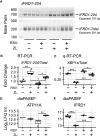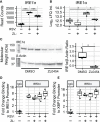Bromodomain-containing Protein 4 regulates innate inflammation via modulation of alternative splicing
- PMID: 37435059
- PMCID: PMC10331468
- DOI: 10.3389/fimmu.2023.1212770
Bromodomain-containing Protein 4 regulates innate inflammation via modulation of alternative splicing
Abstract
Introduction: Bromodomain-containing Protein 4 (BRD4) is a transcriptional regulator which coordinates gene expression programs controlling cancer biology, inflammation, and fibrosis. In the context of airway viral infection, BRD4-specific inhibitors (BRD4i) block the release of pro-inflammatory cytokines and prevent downstream epithelial plasticity. Although the chromatin modifying functions of BRD4 in inducible gene expression have been extensively investigated, its roles in post-transcriptional regulation are not well understood. Given BRD4's interaction with the transcriptional elongation complex and spliceosome, we hypothesize that BRD4 is a functional regulator of mRNA processing.
Methods: To address this question, we combine data-independent analysis - parallel accumulation-serial fragmentation (diaPASEF) with RNA-sequencing to achieve deep and integrated coverage of the proteomic and transcriptomic landscapes of human small airway epithelial cells exposed to viral challenge and treated with BRD4i.
Results: We discover that BRD4 regulates alternative splicing of key genes, including Interferon-related Developmental Regulator 1 (IFRD1) and X-Box Binding Protein 1 (XBP1), related to the innate immune response and the unfolded protein response (UPR). We identify requirement of BRD4 for expression of serine-arginine splicing factors, splicosome components and the Inositol-Requiring Enzyme 1 IREα affecting immediate early innate response and the UPR.
Discussion: These findings extend the transcriptional elongation-facilitating actions of BRD4 in control of post-transcriptional RNA processing via modulating splicing factor expression in virus-induced innate signaling.
Keywords: BRD4; IFRD1; RSV (respiratory syncytial virus); alternative splicing; innate inflammatory response; unfolded protein response.
Copyright © 2023 Mann, Fu, Gearhart, Xu, Roberts, Li, Zhou, Ge and Brasier.
Conflict of interest statement
The University of Wisconsin—Madison holds a patent for the use of Azo in proteomics applications. JZ and AB hold a patent on ZL0454 chemistry. The remaining authors declare that the research was conducted in the absence of any commercial or financial relationships that could be construed as a potential conflict of interest.
Figures






Update of
-
Bromodomain-containing Protein 4 Regulates Innate Inflammation in Airway Epithelial Cells via Modulation of Alternative Splicing.bioRxiv [Preprint]. 2023 Jan 19:2023.01.17.524257. doi: 10.1101/2023.01.17.524257. bioRxiv. 2023. Update in: Front Immunol. 2023 Jun 26;14:1212770. doi: 10.3389/fimmu.2023.1212770. PMID: 36711789 Free PMC article. Updated. Preprint.
References
Publication types
MeSH terms
Substances
Grants and funding
LinkOut - more resources
Full Text Sources
Other Literature Sources
Molecular Biology Databases
Research Materials

